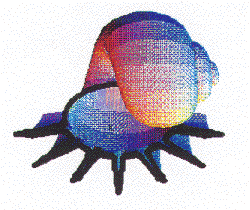Jon R Stone,
State University of New York
The genus Lambis is a member
of the family Strombidae, a group of marine gastropods known as `true
conchs' and renowned for their elaborated labia. In addition to the
siphonal canal, the apertural lips of species of Lambis are adorned
with circumapertural projections (CAPS), fingerlike digitations emanating
from the edge of the aperture. The number of CAPS exhibited by the
nine species currently classified as Lambis ranges between 5 and 11
excluding 7. Two aspects of CAPS have vexed conchologists: how did
CAPS evolve and what is their function (i.e. are they adaptations)?
R. Tucker Abbott [1] classified the
9 species of Lambis, predominantly on the basis of shell morphology.
Implicit in the classification is the assumption that this group of
gastropods with similar shells share a unique common ancestry. The
classification, and the historical relationships it implies, has persisted
with little modification for more than three decades. CAPS have been
postulated to have evolved in an "escalating arms race" as a response
to predation [9], and they have been shown to confer protection against
crushing predators by increasing shell diameter (thereby decreasing
the mechanical advantage of the predators' crushing apparatus), distributing
stress over a large area of the shell, localising stress at the thickest
points of the shell, or creating enormous reactionary forces upon
predators[3]. They have also been hypothesized to provide stability
on substrates (by permitting 'snowshoeing') and to be a means of circumventing
geometric constraints during growth[4]. It is also possible that CAPS
enhance stability via hydrodynamic processes (e.g. drag). A recent
study of the morphological evolution of species of Lambis [7]
yeilds hypotheses concerning the origin and function of CAPS. The
study combines cladistic methodology, mathematical modelling, and
morphospatial analysis. In cladistic analysis[2], information is used
to construct a branching diagram that can be interpreted as depicting
phylogeny. Mathematical modelling of shells has evolved into the discipline
of `theoretical conchology', wherein forms are described by only a
few parameters . Morphospatial analysis has been used to represent
a wide spectrum of organismal forms (usually as points) within mathematical
spaces [8]. The combination of these three tools can be used to define
trajectories in mathematical spaces that describe ontogenies of extant
taxa with reference to phylogeny. The result is that an hypothesis
of the history of morphological evolution of the extant taxa and the
forms of their ancestors can be reconstructed.
The study of the morphological evolution
of Lambis revealed that the current classification of the genus
is untenable. Three species of the genus Strombus are inferred to
be among the most recently evolved members of a monophyletic group
containing all members of Lambis. The number of CAPS among
the 12 species in the monophyletic group is inferred to have varied
during the course of evolution, generally (and most recently) decreasing.
This information can be used to test the hypotheses of adaptation
mentioned before: the adaptive significance of CAPS can be addressed
through experiments that are designed to falsify each hypothesis as
well as by reference to the hypothesised phylogenetic relationships
among species of Lambis and genera of Strombidae. For example, if
CAPS have evolved in an escalating arms race, changes in the number
of CAPS (and the resistance to predation which they confer) and changes
in the crushing ability of predators on independently derived cladograms
should be correlated. The number of CAPS can be altered experimentally
and the modified shells subjected to crushing tests to verify the
causal aspects of any correlations revealed. The results of such practical
experiments might have a significant bearing on `thought experiments'
of theoretical conchology, such as whether `heptaCAPS' lambids (shells
of Lambis with 7 CAPS - see figure 1) ever existed
as ancestors en route to fewer CAPS (as implied by the cladograms)
or could have evolved.
This
work was supported by a Malacological Society of London Centenary
Award to the author.
References
[1]
Abbott R
T (1961) The genus Lambis in the Indo-Pacific. Indo-Pacific Mollusca
1: 147-174.
[2]
Hennig W (1966) Phylogenetic Systematics. University of Illinois Press,
Urbana.
[3]
Palmer A
R (1979) Fish predation and the evolution of gastropod shell sculpture:
experimental and geographic evidence. Evolution 33: 697-713.
[4]
Savazzi E (1991) Constructional morphology of strombid gastropods.
Lethaia 24: 311-331.
[5]
Stone J
R (1995) CerioShell: a computer program designed to simulate variation
in shell form. Palaeobiology
21: 509-519.
[6]
Stone J
R (1996) The evolution of ideas: a phylogeny of shell models. The
American Naturalist 148: 904-929.
[7]
Stone J
R (1997a) The Shell Game: Who's under What? Morphological evolution
and trajectories through morphospace exemplified with species of Lambis.
Ph.D. Dissertation. University of Toronto.
[8]
Stone J R (1997b) The spirit of D'Arcy Thompson dwells in empirical
morphospace. Mathematical Biosciences
142: 13-30.
[9]
Vermeij G J (1989) Evolution and escalation: an ecological history
of life. Princeton University Press, Princeton.
Fig.
1

A
shell with 7 'circumapertural projections'.
A
putative ancestral form unobserved in extant species of the genus
Lambis. The image, which does not depict the siphonal canal,
was simulated using the computer program CerioShell [5].
